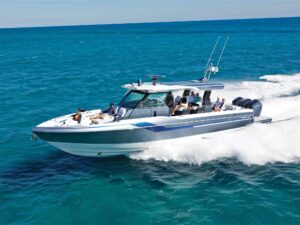The pushpole descends and propels the boat forward so that it glides effortlessly along the flat. The boat silently makes headway as we scan for signs of fish. In the effort to sight and cast to prey, it is easy to overlook one remarkable fact. We are poling in about four inches of water. The bottom of our Seminole flats skiff is floating just above the blades of eel grass bent to accommodate such a low tide. We are able to do this for one reason: Because Ron Hyde wanted to get skinny. As the one time owner of the Goodnews River Lodge in Alaska, and a longtime guide in the Florida Everglades along Florida Bay, he knew it took a special kind of vessel to operate and thrive in extreme shallow-water situations. For inspiration he took a look in his Florida backyard and the old-fashioned Glades skiffs and dugout canoes used by frontiersman and the Seminole Indians. After tinkering with the design, Hyde came up with a flats skiff he feels will be equally at home in the rocky rivers of Alaska and the inches-deep flats of the Florida backcountry: The Seminole.
Secrets of Skinny
The Seminole is long and lean and lightweight, and good for working any type of shallow water. The boat measures 23′ long with a beam of just 4’4″ at the waterline (5′ from gunwale to gunwale at its widest). The base boat weighs 480 pounds. Add in the 60-hp Yamaha four-stroke outboard, a full tank of fuel, the console and other amenities, and it weighs around 830 pounds. So what, other than length and weight, helps the boat get so shallow? The key is the Seminole’s tunnel hull. Hyde built in a tunnel at the transom that extends 5′ forward that is 14″ at its widest and 4″ at its deepest. The tunnel sides act in a similar manner as sponsons on a catamaran, providing stability at rest and increased buoyancy. Underway, the tunnel funnels water to the propeller, which allows Hyde to mount the short-shaft outboard higher up so that the prop can still get bite even if sits above the boats keel. Because of this, we could run the boat on plane in less than 4″ of water without the outboard’s skeg or, more importantly, prop ever hitting bottom. With the length, weight, and tunnel combination, the boat does not need to “dig a hole” to climb on to plane. We brought it on plane in about 6″ of water in a half-second without resorting to a half-turn or leaving a prop scar on bottom.
Fishing Fortitude
Fishing for snook along the mangroves, I hooked a brute that took me where he wanted to go. I had to jump down from the bow platform, make my way along the gunwale topsides, work my way around the casting platform, and dance back up the other side before I got it under control. Usually long and lean means that when at rest, the boat will be tippy. Bad news for flats anglers who don’t want any rattles or noises coming from jostling around on an unstable boat. But for its dimensions, the Seminole is remarkably stable. Hyde built in hard chines that, combined with the tunnel, work to keep the boat from rocking and rolling. But that same long, skinny profile makes it knife through the water while poling. And, thankfully, it is quiet. On two occasions we almost poled over the backs of tarpon before they spotted us and swam away. We could get within 10-20′ feet of many targets without spooking them.
Running Rough
Nothing takes the stuffing out of a fishing trip like an encroaching storm. While on the hunt for permit, Hyde noticed a huge wall of Thunderstorms gathering over the Gulf of Mexico, rolling in fast and ready close out the way between us and safety. Hyde put the throttles down in quartering seas and I braced myself for a kidney pounding that never happened. I’m not suggesting the boat runs offshore like a Contender, but it does have a few traits that make it handle a tight bay chop better than a typical flats boat. Despite its shallow draft, the Seminole mimics true offshore wave runners in that its length-to-beam ratio exceeds 3:1. This allows it to slice through larger waves rather than plow through them. On a small chop, you can take advantage of the Seminole’s 23′ length and run it so it rides atop the waves rather than up and down them. Again, I wouldn’t enjoy running the boat in four footers offshore, but it does have a more comfortable ride than most skiffs I’ve tested.
Fuel Efficiency
**** If speed is your primary objective, the Seminole is not for you. Powered by a 60-hp Yamaha four-stroke outboard, our test boat pushed 30 mph at its fastest. It is rated for 70-hp max, so it will never do much better than that. But what it will do is improve your fuel bill. We ran all day through the back country, with long stretches at just back from wide-open throttle, and burned about seven gallons of fuel. With such a low fuel burn (best is 21 mph at 12 mpg and 2 gph), Hyde feels comfortable equipping the boat with a 16-gallon fuel tank. With that, the Seminole still has a range of approximately 190 miles. The Seminole, all told, is not a boat for everyone. It’s for anglers and boaters whose first priority is to get in and out of shallow water. Which is why Hyde plans to make 10-12 a year. If , like Ron Hyde, you want to get skinny, contact him directly at 954/249-6288, captron3@bellsouth.net.








